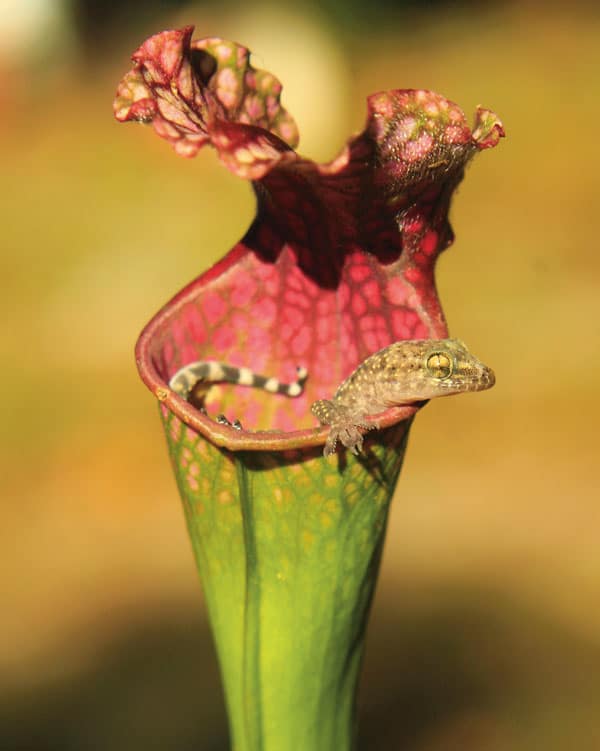Carnivorous plants can be interesting additions to vivariums, but plan carefully.
Although carnivorous plants have been portrayed as nearly sentient aberrations of nature, the reality is that carnivory developed in multiple, unrelated plant groups as a strategy to survive and thrive in nitrogen-depleted soils. Carnivorous plants are found overwhelmingly, with a few exceptions, in acidic, nutrient-poor soils, where other plants grow slowly if at all. They are found on every continent except Antarctica and can often be found in surprising circumstances. I have observed common butterwort (Pinguicula vulgaris) growing atop a boulder near the summit of a mountain in the Canadian Rockies, just outside of Banff National Park in Alberta. This species can also be found in surprising numbers in the Pine Barrens of New Jersey, along the Pacific Coast of California and Oregon, in marl bogs in Michigan, and sandy scrub all along the coast of Australia. One of the widest varieties of carnivore groups hails from just outside of Tallahassee, Fla., including huge stands of American pitcher plants (Sarracenia), bladderworts, sundews, and even a population of Venus flytraps.
Defining Carnivore
The definition of a carnivorous plant is a plant that can attract, capture and digest prey with digestive compounds. Structures needed for attraction and capture, and enzymes needed for digestion, require a tremendous amount of energy and resources that could otherwise be used for growth. Because of this, carnivores grow slowly compared to other plants. In the wild, many species are threatened or endangered due to habitat destruction. Many habitats suitable for carnivorous plant growth also happen to be prime reptile and amphibian habitat, and some have co-evolved to take advantage of each other.
To date, all known carnivorous plants flower, with the vast majority being dicots — plants that produce two leaves at a time upon sprouting, like bean shoots. Two exceptions, the carnivorous bromeliads Brocchinia and Catopsis, hail from the monocots —plants that produce one leaf upon sprouting, like corn or grasses — but share many of the same care requirements as dicots.
The Right Conditions
Carnivores need a lot of light to produce capture structures and digestive enzymes. Most do best with six to eight hours of direct sunlight per day. To thrive, they need acidic, nutrient-poor soil. Most prefer a 50/50 mix of sphagnum moss and silica or “sharp” sand. Fertilizing a carnivore with standard fertilizers will kill it, as the salts in most fertilizers burn off their roots. Likewise, the safest course for watering is to use rainwater or distilled water, as many municipal water supplies have far too many salts, as well as added chlorine and fluoride, to allow carnivore survival. In short, the same substrate and water requirements for many treefrogs and salamanders also work best for carnivorous plants.
Given their range, carnivores can best be put into one of two categories: tropical or temperate. Tropical carnivores live in areas that never face freezing temperatures, and most do best when never exposed to temperatures below 50 degrees Fahrenheit. Temperate carnivores are more tolerant of lower temperatures, but to survive freezing, they go dormant during the winter. All native North American carnivores generally slip into a winter dormancy no later than the end of November (after temperatures drop consistently near freezing in higher latitudes) and don’t emerge from dormancy until spring. At that time, they usually bloom before producing new traps. Winter dormancy is vital for a plant’s survival. Attempting to force a temperate carnivore to remain active will eventually lead to its death.
This article will focus on carnivorous plant species best suited for beginners, as many others require special care or conditions that may not be healthy for most commonly available herps.
Avoid Venus Fly Traps
Venus flytraps (Dionea muscipula) may be the most famous carnivorous plants, and they’re usually the first considered as a vivarium addition, but please resist the temptation. They are fussy about soil and water quality, and they require six to eight hours of direct sun every day. They must have a full-winter dormancy, and they weaken and die without it. They produce traps large enough to capture small herps, such as frogs and hatchling lizards, and they remain small enough to be trampled by larger herps. Contrary to popular opinion, they cannot be fed hamburger, and setting off their traps without prey in them draws off energy better used for dormancy.
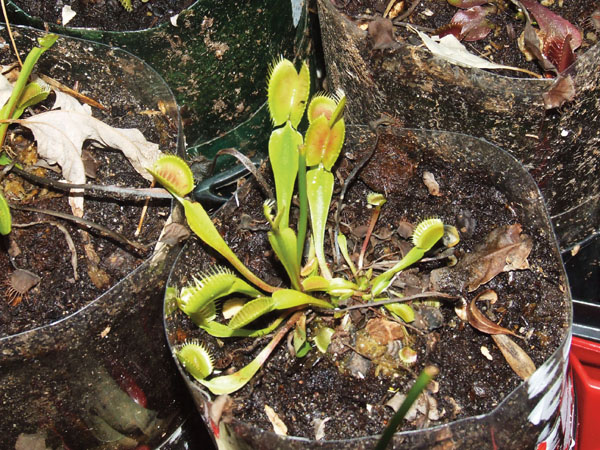
class="photo-credit">paul riddell
class="photo-description">Venus fly trap
Pitcher Plants
(Sarracenia and Nepenthes)
Five distinct genera of plants go by the common name “pitcher plant,” including the cobra plant (Darlingtonia) of the Pacific Coast of North America, the “sun pitchers” (Heliamphora) of the Tepui plateaus of Brazil and Venezuela, and Cephalotus of Australia. The most likely to be encountered via sellers, as well as those best suited for life with herps, are two otherwise unrelated groups: Sarracenia and Nepenthes.
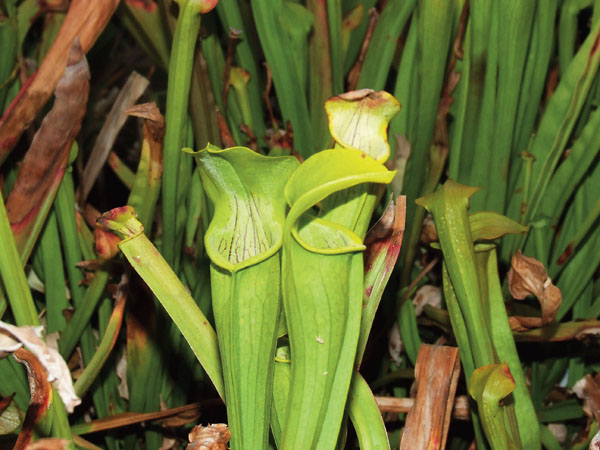
class="photo-credit">paul riddell
class="photo-description">Like other pitcher plants, those of the genus Sarracenia attract insect prey with bold colors and fragrant nectar. This is a hybrid from the Gulf Coast of the U.S.
The North American pitcher plants of the genus Sarracenia are temperate carnivores that range along the southern portion of the United States, from eastern Texas to the Atlantic Ocean. Most species are native to Mississippi, Alabama, Georgia and northern Florida, with one species, S. purpurea, ranging up the Atlantic coast to Newfoundland and Labrador and then west through Ontario and Michigan.
Asian pitcher plants, genus Nepenthes, are tropical carnivores found along the Indian Ocean in Africa, Madagascar, the Philippines, Australia and mainland China, with the greatest concentration of species in Borneo. They grow a distinctive pitcher from the tip of a tendril or “rib” extending from each wide, flat leaf. The inside of the pitcher is highly reflective in ultraviolet light, and the lip of the pitcher secretes nectar, attracting both flying and crawling insects. Drawn by more nectar secreted within the throat of the pitcher, insects that go too far slide down the waxy interior into a pool of fluid at the bottom. This acidic fluid contains digestive enzymes and a recently described liquid polymer that inhibits the prey’s movements. The victim eventually drowns in the fluid, and its nutrients are absorbed through specialized glands on the pitcher’s inner wall.
Sarracenia pitchers work much the same way, even though they grow in a completely different manner. They also draw in prey via nectar and bold patterns seen in both visible and ultraviolet light, and they encourage prey to climb inside for more nectar. The interior of the Sarracenia pitcher, though, is lined with strong and sharp downward-pointing hairs, which force trapped prey further into the pitcher. When the prey reaches the bottom, the plant secretes digestive fluids that break it down, with the help of symbiotic bacteria and other microscopic organisms.
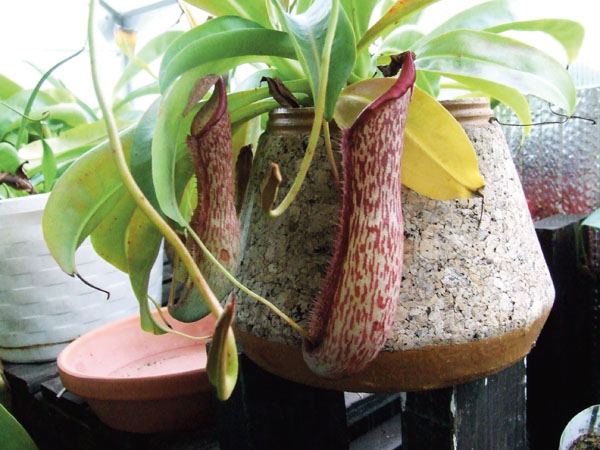
paul riddell
class="photo-description">This is a hybrid of two Nepenthes species that is called Nepenthes “Miranda.” It is a good choice for beginner carnivorous plant keepers due to its forgiving nature in regard to humidity and light intensity fluctuations.
Although many of the larger Nepenthes species are renowned for their capacity (the recently described Philippine giant, N. attenboroughii, has a pitcher capacity of as much as 4 liters), they generally aren’t known for catching vertebrate prey. If anything, lizards and frogs tend to wait for prey alongside, or even inside, Nepenthes pitchers. In China, treefrogs live and hide inside the pitchers of N. mirabilis, and the smallest frog in Asia, Microhyla nepenthicola, was just described as laying its eggs and raising its tadpoles within the pitchers of N. ampullaria. (Considering that N. ampullaria is the one known Asian pitcher plant that captures more dead leaves and other vegetable matter than animal prey, the possibility that the plant receives nitrogen from tadpole waste might make a fascinating research paper.) Even with cultivated plants, Hyla treefrogs regularly camp within the pitchers, capturing prey and then later defecating within, effectively predigesting insect prey too large for the plant to digest on its own.
Many Nepenthes species thrive in larger enclosures with high-intensity light or full sunlight, with temperatures ranging from 50 to 95 degrees Fahrenheit and humidity of at least 50 percent. They make a wonderful companion plant for many lizard species. As the plants grow, they tend to produce long tendrils strong enough to be chameleon-friendly plants. In my greenhouse, I find native green anoles (Anolis carolinensis) and imported Mediterranean geckos (Hemidactylus turcicus) sleeping and hunting for prey among the leaves of big Nepenthes vines. For beginners, the Nepenthes hybrid “Miranda” is an excellent choice, as it is quite forgiving of fluctuations in humidity and light intensity, and this species produces gigantic pitchers when well-fed.
In the wild, Sarracenia pitchers are also attractive to treefrogs, which use them as hiding spots, hunting lookouts and toilets. This benefits both frog and pitcher plant. Some of the larger Sarracenia species, particularly the white pitcher plant (S. leucophylla), attract treefrogs, which watch for food and for predators. Frogs found trapped inside may well have died of natural causes. In captivity, Sarracenia makes a poor indoor plant due to its need for intense light and winter dormancy, but it would be a good choice when setting up a bog garden in an outdoor water turtle enclosure. They snag flies, wasps and other pest insects. The leaves are too bitter even for red-eared sliders to eat, and the plants can go into dormancy at about the same time the turtles enter winter hibernation. Sarracenia do very well in low humidity so long as they are well-watered, and they tolerate higher temperatures. They generally slow or stop their growth after a few weeks exceeding 95 degrees Fahrenheit, but they come back with new and even more brightly colored pitchers when the temperatures cool during the autumn.
Sundews (Drosera)
Sundews are just one of the many carnivorous plant groups that capture prey on specialized hairs that secrete a sugary adhesive, but they’re the most common. They have the ability to move those hairs to engulf trapped prey, and many can also move their leaves to clutch prey. As such, this can be a direct threat to smaller herps, and many of the larger sundews will have have no problem catching and digesting small frogs and lizards.
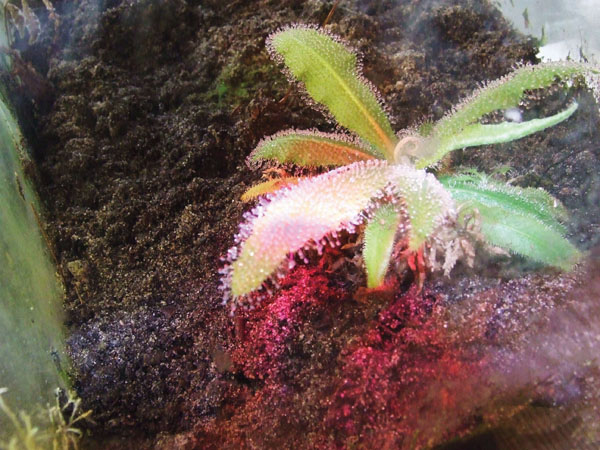
paul riddell
The Australian lance-leaved sundew (Drosera adelae) needs less direct light than most of its kin and is more suited for vivarium life.
On the other hand, sundews are an effective way of controlling fungus gnat and fruit fly infestations in a vivarium, so long as the humidity is kept above 60 percent. The Australian lance-leaved sundew (Drosera adelae) is more suited for life in a vivarium than any other carnivorous plant, as it needs less direct light than most of its kin. Other tropical varieties, such as the spoon-leaved sundew (D. spatulata), can be kept in enclosures containing Madagascar day geckos, as the plants almost never get large enough to capture an adult gecko. Sundews from temperate climes, such as D. rotundifolia or D. anglica, thrive in temperatures between 41 to 95 degrees, but they will need a winter dormancy period. Tropical species, such as D. adelae, should never be kept below 50 degrees but they also don’t require a dormancy period.
Bladderworts (Utricularia)
Bladderworts comprise the largest family of carnivorous plants, being found in moist habitats on all continents but Antarctica. All bladderworts grow miniscule bladders, hence the name, which slurp up equally miniscule prey that set off sensory hairs on each bladder. Some of the aquatic bladderworts produce bladders that are large enough to capture mosquito larvae, but terrestrial bladderwort species snag only microscopic soil organisms, such as nematodes.
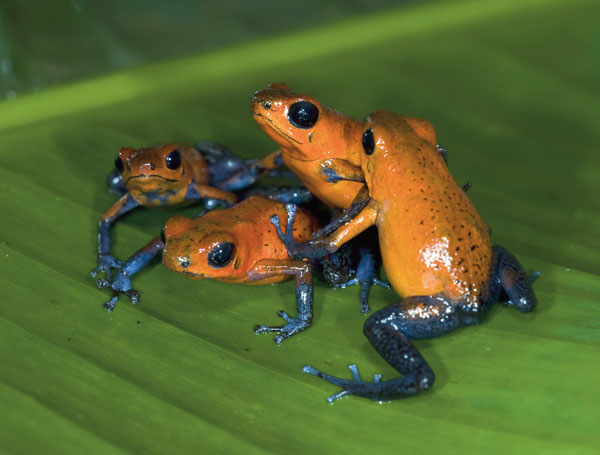
paul riddell
Dart frogs, including strawberry dart frogs (Oophaga pumilio), are good candidates for a vivarium containing carnivorous plants, such as bladderworts. Beware sundews, though they might catch and digest the frogs!
Bladderwort prey is so small that the plants can be considered guilt-free carnivores. They don’t need special feeding, they grow in moist soil mixes suitable for dart frogs or lungless salamanders, and they produce impressive orchidlike flowers. The terrestrial bladderwort Utricularia sandersonii is a personal favorite for vivariums, as it grows rapidly and produces purplish-blue and white flowers. Keep the substrate very moist and supply suitable light, and U. sandersonii will rapidly grow through a vivarium, sprouting blooms the entire time. As with other tropical carnivores, U. sandersonii thrives at temperatures between 50 and 95 degrees, and the higher the humidity, the faster the plant’s growth.
Aquatic bladderworts are also a favorite of treefrogs. In the spring, Jacob Farin and Jeff Dallas of Sarracenia Northwest, a carnivorous plant nursery just outside of Portland, Oregon, dread the mating call of the local Pacific treefrog (Pseudacris regilla). Adults frogs love using the breeding pools used for raising aquatic bladderworts to lay their eggs, and the tadpoles love eating bladderworts. One tadpole clutch can strip out dozens of bladderworts, making them very expensive treefrog food.
Triggerplants (Stylidium)
One of the more intriguing plant groups to be treated as carnivorous, or at least proto-carnivorous, in the last decade is the triggerplant family, genus Stylidium. Although a few species are known from Japan and Tierra del Fuego, the overwhelming majority are found in Australia. The main common feature between all species is a flower with four petals and a “column,” which cocks back over the flower like the hammer of a gun. This column acts much the same way as a hammer, too; when an insect lands on the flower to search for nectar, the column whips forward and tags the insect with a dollop of pollen. Not only is this faster than movement in a Venus flytrap or mimosa, many species’ columns move faster than the human eye can follow.
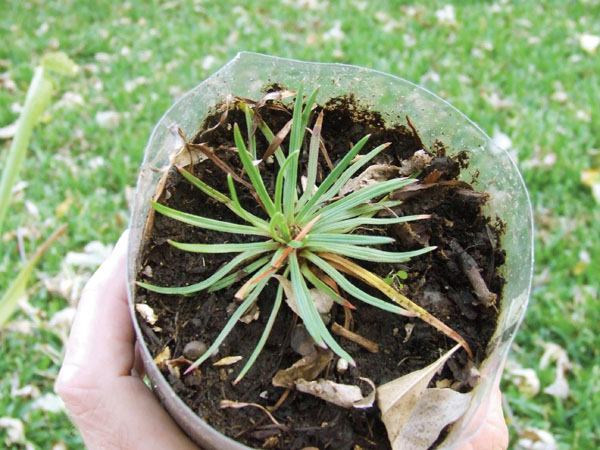
paul riddell
The grassy triggerplant (Stylidium graminifolium) produces a long, tall, flower scape during the spring, covered with bluish-violet blooms.
When the triggerplant blooms, the flower scape produces sticky threads, much like a sundew’s, which capture tiny insects, such as fungus gnats. For nearly a century, triggerplants were thought to be proto-carnivorous at best, but the presence of digestive enzymes was confirmed in 2006. With their inclusion, triggerplants doubled the number of known carnivorous plants (however, that inclusion is still fiercely debated by some experts).
Both of the most commonly raised triggerplants in captivity, the grassy triggerplant (S. graminifolium) and the frail triggerplant (S. debile), are suitable to house with herps. The grassy triggerplant produces a long, tall flower scape in spring, covered with bluish-violet blooms, but otherwise it produces large clumps of long, grassy leaves with a rough resemblance to monkey grass (Ophiopogon japonicus).
Stylidium graminifolium can handle mild winters outdoors. As long as it’s protected from freezing weather that lasts longer than two or three days, it does well in outdoor herp enclosures, and it thrives at temperatures above 50 degrees. It is also much more tolerant of low humidity, and grows and blooms in humidity levels running as low as 10 percent during the day. Once grown to a suitable-sized clump (usually after three years of growth from seed), it’s also tough and resilient enough to handle the occasional tromping by larger herps. In particular, it shows no sign of toxicity with most turtles, and could be an alternative border plant for outdoor box turtle or tortoise pens if otherwise treated like other carnivores as far as soil mix and water are concerned.
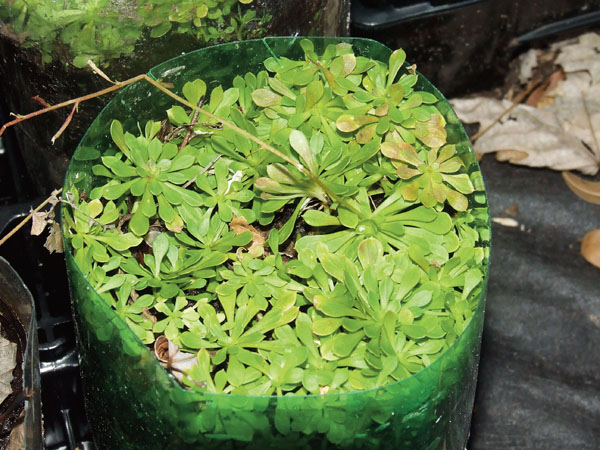
paul riddell
The frail triggerplant (Stylidium debile) is one of the most commonly raised triggerplants in captivity, and it is suitable to house with.
Stylidium debile, by comparison, is a thin-leaved, ground-cover plant, putting out small rosettes of plantlets that are from root offshoots and rapidly fill its container. It requires considerably more water than S. graminifolium, but it’s also more tolerant of lower light, making it a better plant for indoor enclosures. Keep S. debile a bit more humid, at 40 to 90 percent relative humidity, and keep it between 41 and 95 degrees. At temperatures above 95 degrees, the plants will die back, but usually resprout from the roots once temperatures fall below 86 degrees. It produces long, wiry scapes covered with neon pink flowers, with a tendency to produce them all year round. As such, these make one of the most herp-friendly carnivores regularly available, and they are particularly well-suited for smaller animals, such as dart frogs or day geckos.
Beauty and Versatility
Although carnivorous plants aren’t carefree plants, they offer plenty of advantages for the herpkeeper seeking variety. Some can be used to deal with vivarium pests, but most simply make a good addition to new or established setups. Beauty, danger and versatility at the same time — carnivorous plant enthusiasts may be alternately horrified, fascinated and thrilled. They are never bored.
Sourcing Plants
Many small and large nurseries carry the most common carnivorous plants, such as Venus flytraps and Sarracenia pitcher plants. Finding the more obscure plants necessitates visiting nurseries specializing in carnivores. Some the author recommends include:
- California Carnivores; Sebastopol, California; californiacarnivores.com
- Sarracenia Northwest; Portland, Oregon; cobraplant.com
- Black Jungle Terrarium Supply; Turners Falls, Massachusetts; blackjungleterrariumsupply.com
- The Nepenthes Nursery; Germany; wistuba.com
- Triffid Park; Victoria, Australia; triffidpark.com.au
Take Heed
By definition, carnivorous plants capture animal prey, and this usually entails any prey small enough to be subdued. Many of the species listed herein are able to capture hatchlings of small herps, and they have been confirmed in many cases as capturing and digesting skinks, geckos, frogs and toads. Keeping carnivorous plants with reptiles and amphibians means risking a pet or breeding specimen being captured and consumed by an appropriately sized carnivorous plant. Always research a carnivore before adding it to a herp enclosure. Any herp that can be captured by a carnivore will be captured sooner or later.
Paul Riddell became hooked on carnivorous plants in 2002, after moving to Tallahassee, Fla. He currently operates the Texas Triffid Ranch (txtriffidranch.com), a small carnivorous plant nursery in Dallas.

